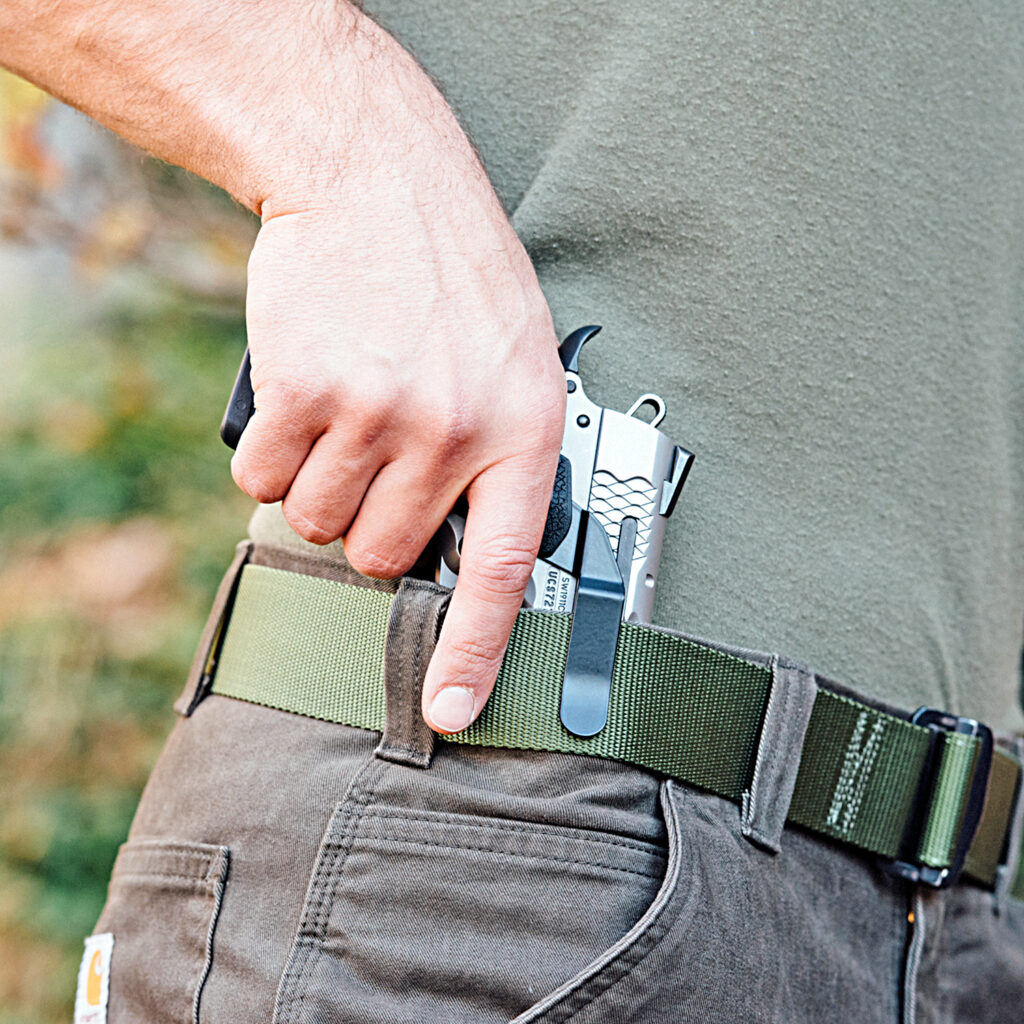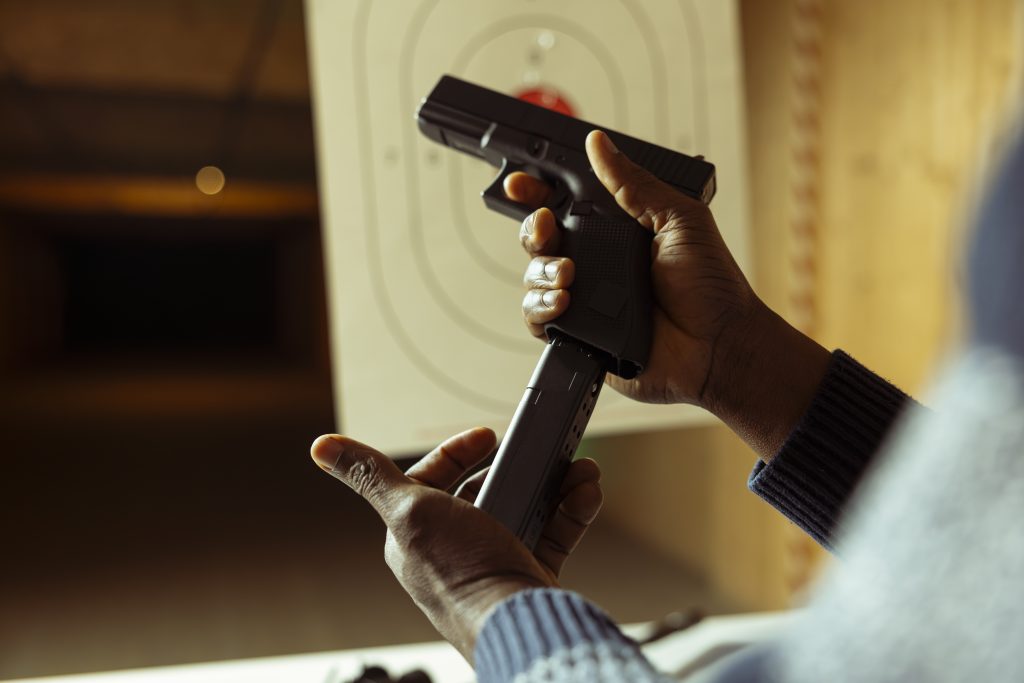Critical moments can occur anywhere without warning. Whether you’re behind the wheel of a vehicle or dining at a restaurant, knowing how to draw your firearm quickly and safely while seated is essential for concealed carry holders. Below are common questions and answers that will help you take the necessary steps to learn this critical skill.
Why is Drawing From Concealment While Seated Different from Standing?
When seated, you face several physical challenges that can interfere with your ability to draw your firearm. These include:
- Restricted mobility in your legs and upper body.
- Seatbelts that obstruct access to your firearm.
- Table edges or tight seating that limit arm movement.
- The potential of being in a close-quarters environment where an assailant is within arm’s reach.
These factors make drawing from concealment while seated more complicated than standing draw techniques and require specific training and planning.
What is the Best Holster Position for Drawing While Seated?
The best holster position depends on your body type, seating scenarios, and clothing, but here are common options that support effective concealed carry draw techniques for seated positions:
- Appendix Inside the Waistband (AIWB): This appendix carry method offers quick access to your concealed pistol, especially in vehicles. However, it may be uncomfortable for long periods of sitting and must be practiced extensively to ensure safe reholstering.
- Cross-Draw: This technique is particularly helpful in vehicles or when seatbelts block strong-side access. It allows the firearm to be drawn across the body with minimal obstruction.
- Shoulder Holsters: While this option can be useful when seated, it can also require wearing cumbersome clothing choices and present retention challenges.
- Gun Clip Waistband Carry: This choice simplifies access to a concealed pistol by eliminating the bulk of traditional holsters and allowing flexible placement around your waist.
No matter which preferred carry method you choose, it’s important that you ensure that the firearm is secure and the trigger guard is protected.
How Do You Draw Your Firearm in a Vehicle?
Drawing your firearm in a vehicle requires overcoming the added obstacle of a seatbelt and limited space.
Here are safe, efficient steps to consider:
- Practice with an Unloaded Pistol: Rehearse movements at home in your vehicle, parked in your driveway, to develop muscle memory.
- Incorporate Your Non-Dominant Hand in Your Practice Routines: Use your dr to sweep away clothing and release the seatbelt.
- Adjust Your Position: Lean forward or to the side slightly when drawing to create space between your body and the seat.
- Be Mindful of Safety: Draw smoothly and keep the muzzle pointed safely throughout the motion.
If you carry your concealed pistol appendix-style or use a Clipdraw attachment, this process can be faster and less restrictive than when using bulky holsters.
How Should You Draw Your Concealed Pistol While Seated at a Table?
When seated at a restaurant or desk, table interference and social context add complexity.
Here’s how to manage it:
- Angle Your Body Slightly: Making this adjustment creates space between the table and your holster to help limit obstructions.
- Avoid Dramatic or Sweeping Movements: These actions could attract attention or cause you to bump furniture.
- Use Your Support Hand to Discreetly Move Clothing: Take the time to remove these obstacles and allow your dominant hand to smoothly and effectively initiate the draw.
- Practice Dry-Fire Drills Using a Simulated Table Edge: Dry fire practice at home helps you build familiarity with the movement under pressure.
The more discreet and efficient you are when drawing from concealment while seated, the more likely you are to maintain control in a high-stress situation.
How Do Clothing Choices Affect Drawing from Concealment While Seated?
Your clothing plays a major role in how quickly and safely you can access your firearm.
Consider these tips:
- Wear Cover Garments with Stretch or Give: Opting for untucked button-downs or lightweight jackets helps with concealment while allowing you to draw more effectively.
- Avoid Wearing Stiff Belts or Tight-Fitting Pants: Wearing tight clothing or restrictive accessories can hinder your draw.
- Choose Versatile, Layered Outfits: Opt for outfits that keep your pistol concealed, yet allow you to easily access your pistol from the front or side, depending on your carry position.
- Minimize Holster Bulk: Clipdraw gun clips help minimize bulk so users can benefit from faster access to their concealed pistol regardless of outerwear.
Clothing should never make you work harder to defend yourself. The right outfit complements your carry system.
What are the Best Ways to Practice Drawing from Concealment While Seated?
Practicing your draw in realistic settings is key to readiness.
Here are some practice methods that can help build confidence and strengthen your skills:
- Dry Fire Drills at Home: Use a cleared firearm to rehearse drawing from various seated positions such as cars, desks, couches, or restaurant chairs.
- Range Drills: If possible, use seating props or platforms at your range to simulate real-world scenarios.
- Start Slow: Build your technique before adding speed.
- Record Your Practice Sessions with Your Phone: Reviewing video footage of your practice sessions helps you identify potential issues such as wasted movements or unsafe angles.
- Train for Maximum Pistol Retention: Learn how to maintain control of your pistol in close-quarters situations where someone may try to grab it from you.
Remember, every repetition builds muscle memory that may save your life.
Which Accessories Can Help with Drawing Your Pistol While Seated?
The right gear can simplify access and improve safety. Consider:
- Clipdraw Gun Clips: These alternatives to traditional holsters reduce bulk and allow for versatile placement, especially when practicing appendix or cross-draw carry methods.
- Clipdraw Trigger Guards: These accessories are essential for concealed carry setups to prevent accidental discharge.
- Reversible Gun Clips: These accessories let you adapt your draw for left- or right-handed scenarios.
Having reliable, well-placed accessories makes drawing from concealment while seated faster and safer.
Why It’s Important to Practice Drawing While Seated
You can’t control when or where a threat may appear, but you can prepare yourself to respond. Knowing how to draw your firearm in a vehicle, at a table, or in other seated positions gives you a tactical advantage when seconds count.
The key is consistent training, thoughtful clothing choices, and reliable gear that supports safe, efficient movement. Practicing concealed carry draw techniques for seated positions ensures you’re ready to respond with confidence, no matter where you are.
Upgrade your concealed carry setup with Clipdraw gun clips and accessories today!


